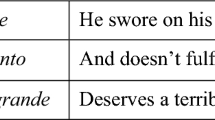Abstract
The reoccurrence of Margaret Thatcher’s image and memory through single-frame political cartoons in the years surrounding the 1997 General Election signaled that in addition to the immediate question of leadership to be decided between John Major and Tony Blair, the election was also about the unresolved legacies of Thatcher and Thatcherism. Given the tendency of political cartoonists to portray the Conservative and Labour parties “only through their most recent leaders and supporters” (Mumford 2001, p. xi), political cartoons that gloss over Major (and Major’s successor William Hague) reflect Thatcher’s domination of the late twentieth-century political landscape despite her departure from political office. Depictions of Thatcher in relation to Blair by political cartoonists in both liberal and conservative dailies, in this respect, can be read as symptomatic of widespread anxieties regarding the continuation of Thatcherism in the late 1990s. Rather than setting Thatcher and Blair in opposition to each other as might be expected, however, Peter Brookes and Michael Cummings of the Times and Peter Schrank and Dave Brown of the Independent, for example, tend to efface differences between the politicians and, in doing so, treat Blair as either a repetition or parody of Thatcher.1
Access this chapter
Tax calculation will be finalised at checkout
Purchases are for personal use only
Preview
Unable to display preview. Download preview PDF.
Similar content being viewed by others
Works cited
Aughey, A. (2007) The Politics of Englishness. Manchester: Manchester University Press.
Benson, T. S. (2007) The Cartoon Century: Modern Britain Through the Eyes of its Cartoonists. London: Random House.
The British Cartoon Archive (2009) “Peter Brookes,” http://www.cartoons.ac.uk/artists/peterbrookes/biography. Accessed April 20, 2009.
Brookes, P. (1996) “Happy Family Values,” The Times, October 16, p. 22.
Brookes, P. (1997) “Singular Mother,” The Times, December 11, p. 22.
Brookes, P. (1997) “Maggiepies,” The Times, January 11, p. 26.
Brookes, P. (1998) “The Third Way,” The Times, September 30, p. 20.
Brown, D. (1997) The Independent, April 11. The British Cartoon Archive, University of Kent, catalogue record PC1291, http://www.cartoons.ac.uk. Accessed May 20, 2009.
Brown, D. (1999) The Independent. April 27. The British Cartoon Archive, University of Kent, catalogue record DB0192, http://www.cartoons.ac.uk. Accessed May 20, 2009.
Brown, D. (2002) The Independent. November 26. The British Cartoon Archive, University of Kent, catalogue record 63048, http://www.cartoons.ac.uk. Accessed May 20, 2009.
Butler, J. (1990) Gender Trouble: Feminism and the Subversion ofIdentity. New York: Routledge.
Cannadine, D. (2003) In Churchill’s Shadow: Confronting the Past in Modern Britain. Oxford: Oxford University Press.
Cummings, M. (1997) “I thought I was a Super-Nanny until I saw YOU!,” The Times Magazine, August 2, p. 3.
Garber, M. (1992) Vested Interests: Cross Dressing and Cultural Anxiety. New York: Routledge.
Greenberg, J. (2002) “Framing and Temporality in Political Cartoons: A Critical Analysis of Visual News Discourse.” The Canadian Review of Sociology and Anthropology, 39 (2): 181–98.
Hall, S. (1979) “The Great Moving Right Show,” Marxism Today, 23 (1): 14–20.
Hall, S. (1987) “Blue Election, Election Blues,” Marxism Today, 31 (7): 30–5.
Hall, S. (1988) The Hard Road to Renewal: Thatcherism and the Crisis of the Left. London: Verso.
Jenkins, S. (1998) “The Invisible Party: Blair may Bully the Left in Blackpool but Real Labour will be Back One Day,” The Times, September 30, p. 20.
Jenkins, S. (2006) Thatcher and Sons: A Revolution in Three Acts. London: Allen Lane.
Marr, A. (2007) A History of Modern Britain. London: Macmillan.
Morris, R. N. (1993) “Visual Rhetoric in Political Cartoons: A Structuralist Approach,” Metaphor and Symbolic Activity, 8 (3): 195–210.
Morris, R. N. (1995) The Carnivalization of Politics: Quebec Cartoons on Relations with Canada, England and France, 1960–1979. Montreal: McGill-Queen’s University Press.
Mumford, A. (2001) Stabbed in the Front: Post-War General Elections through Political Cartoons. Canterbury, Kent: Centre for the Study of Cartoons and Caricature, University of Kent.
Nairn, T. (2002) Pariah: Misfortunes of the British Kingdom. London: Verso.
Nunn, H. (2002) Thatcher, Politics and Fantasy: The Political Culture of Gender and Nation. London: Lawrence & Wishart.
Press, C. (1981) The Political Cartoon. Madison, NJ: Fairleigh Dickinson University Press.
Reitan, E. A. (2003) The Thatcher Revolution: Margaret Thatcher, John Major, Tony Blair and the Transformation of Modern Britain, 1979–2001. Lanham, MD: Rowman & Littlefield.
Riddell, P. (1997) “New Mood Gives Blair a Dose of Political Reality,” The Times, December 11, p. 12.
Riddell, P. (2005) The Unfulfilled Prime Minister: Tony Blair’s Quest for a Legacy. London: Politico’s.
Rose, J. (1995) “Margaret Thatcher and Ruth Ellis” in E. Carter, J. Donald and J. Squires (eds), Cultural Remix: Theories of Politics and the Popular. London: Lawrence & Wishart.
Ross, E. (2006) “The Representation of Immigrants and Immigration in UK Political Cartoons from 1968 to 2005,” International Journal of Comic Art, 8 (2): 283–306.
Seymour-Ure, C. (2003) Prime Ministers and the Media: Issues of Power and Control. Malden, MA: Blackwell.
Schrank, P. (1997) The Independent, May 26. The British Cartoon Archive, University of Kent, catalogue record PC1866, http://www.cartoons.ac.uk. Accessed May 20, 2009.
Walker, M. (1977) Daily Sketches: A Cartoon History of Twentieth-Century Britain. London: Muller.
Warner, M. (1996) Monuments & Maidens: The Allegory of the Female Form. London: Vintage.
Webster, W. (1990) Not a Man to Match Her. London: Women’s Press.
Editor information
Editors and Affiliations
Copyright information
© 2010 Heather Joyce
About this chapter
Cite this chapter
Joyce, H. (2010). Parodic Reiterations: Representations of Margaret Thatcher and Thatcherism in Late Twentieth-Century British Political Cartoons. In: Hadley, L., Ho, E. (eds) Thatcher & After. Palgrave Macmillan, London. https://doi.org/10.1057/9780230283169_11
Download citation
DOI: https://doi.org/10.1057/9780230283169_11
Publisher Name: Palgrave Macmillan, London
Print ISBN: 978-1-349-31338-9
Online ISBN: 978-0-230-28316-9
eBook Packages: Palgrave Media & Culture CollectionLiterature, Cultural and Media Studies (R0)




